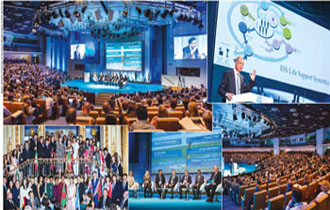WATER SECURITY
LMD OCTOBER 2017
WINNING THE WATER WAR
Yamini Sequeira sounds a cautionary note on water depletion in Asia and the Pacific
 The report was released at a recent event held to mark World Water Week in Stockholm under the theme ‘Water and waste – reduce and reuse.’
The report was released at a recent event held to mark World Water Week in Stockholm under the theme ‘Water and waste – reduce and reuse.’
It provides a snapshot of the water security situation of 48 nations in the region, indicating that Asia and the Pacific remain the world’s most vulnerable regions to water insecurity and cannot sustain economic growth without addressing this issue.
Bridging the gap in the provision of water services between the rich and poor in urban areas, as well as between rural and urban areas in these countries, is a key challenge. South Asian nations particularly need to make considerable efforts to improve their performance in this regard.
Moreover, the ADB report notes that there is “a strong relationship between water management and the economy, and investments in good water management can be considered a longer term payback for increased growth and poverty reduction. Water related investments can increase economic productivity and growth, while economic growth provides the resources to invest in institutions and capital intensive water infrastructure.”
ADB statistics indicate that developing Asia will need to invest US$ 26 trillion between 2016 and 2030 (that’s 1.7 trillion dollars a year) if the region is to maintain its growth momentum, eradicate poverty and respond to climate change. Investments in water and sanitation will amount to US$ 800 billion over the period, which is a tall order for developing nations.
The report also states that in Asia and the Pacific, 1.7 billion people lack access to basic sanitation. Recent estimates suggest that by 2050, 3.4 billion people could be living in water stressed areas in these regions while demand increases by 55 percent.
Moreover, in nearly half the economies, piped water supplies are higher than 85 percent although less than 50 percent of the urban population has access to improved sanitation. In many areas, the majority of wastewater is discharged into the environment, having received little or no treatment. The report says that substantial investment and leadership is needed to reliably meet the water needs of cities.
Moreover, in terms of resilience to water related disasters, advanced economies boast the strongest performance while much of the rest of Asia and the Pacific has been weak. Between 1995 and 2015, more than 2,495 water related disasters have struck Asia, killing 332,000 people and affecting a further 3.7 billion.
South Asia has the lowest resilience score as recent floods in Bangladesh, India and Sri Lanka bear witness to.
Expanding populations, rapid urbanisation, rising water pollution and competing demands for water have left resources in many Asian countries in dire straits. The gap between demand and supply is widening, and thereby increasing competition between water users such as farmers, energy producers, households and businesses. And Asia is running out of water for the future. Around 70 percent of the region’s water is utilised to irrigate crops but much of it is used inefficiently.
Meanwhile, many nations waste large volumes of treated water through leakages in urban supply systems. The good news however, is that by using remote sensing technology, water productivity can be measured right down to the farm level for the first time, thus impacting the planning of future water projects.
Closer to home, there’s a water crisis on hand. An expert has suggested that Sri Lanka needs a whopping Rs. 350 billion in investments in the water sector by 2020 if the targeted 60 percent of the population is to receive drinking water.
But the practice of extending subsidies across the board prevents the country from constructing the infrastructure needed for water supply and drainage. There is a feeling that unless the charge for water is increased, efforts to encourage the responsible use of the resource and explore alternative sources of procuring it will remain weak.
Considering the unpredictable rainfall patterns experienced in recent years, droughts and floods are expected at more regular intervals while groundwater contamination due to agrochemicals is already threatening livelihoods and the health of farmers.
What’s more, climate change is leaving Sri Lanka increasingly vulnerable. Once known for its engineering skills in building a complex grid of water tanks and canals that nurtured the nation’s agriculture sector even in the dry zones, Sri Lanka is struggling to provide water to all its people today.
According to an urban myth, the next world war will be triggered by nations competing for water sources. While water wars may sound like an exaggeration to some, political and social tensions over water have been reported in many nations.
Even though Sri Lanka is synonymous with plentiful natural resources, the scarcity of safe drinking water, rising river pollution, and the effects of climate change such as disrupted rainfall patterns and periods of drought could mean a weakening of water security.



